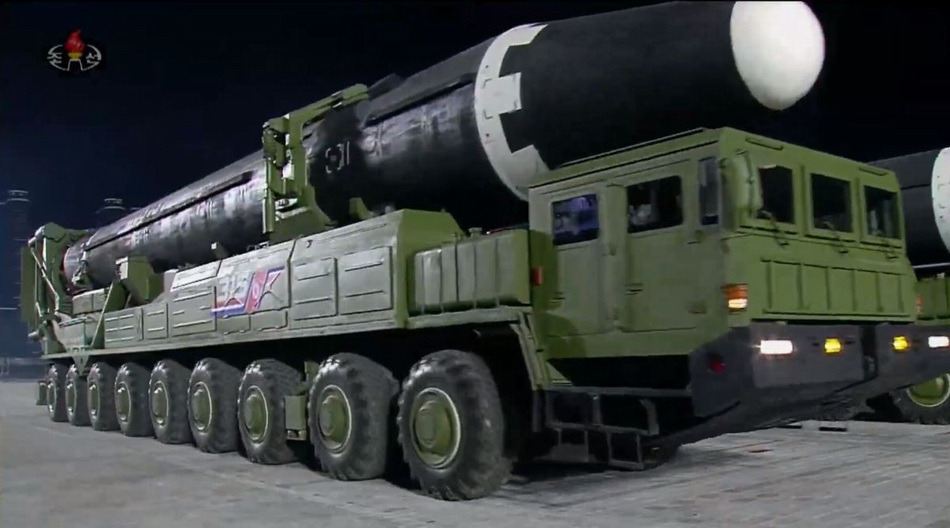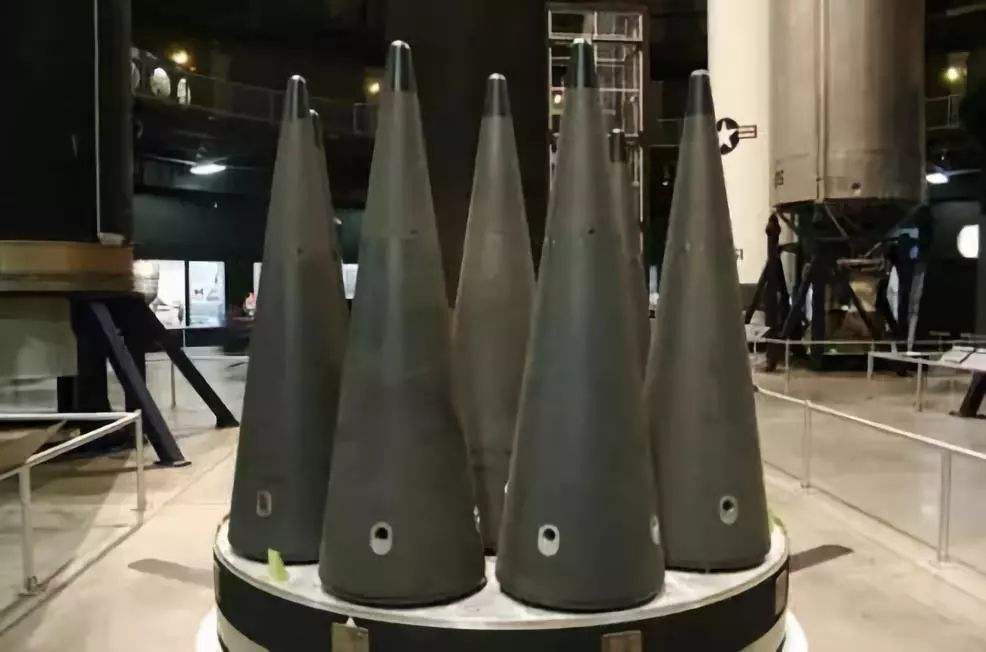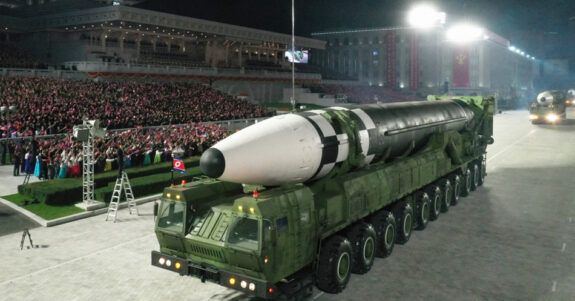Tactical nuclear weapons, nuclear submarines, multi-warhead technology, hypersonic missiles… North Korea has recently focused on publicizing new developments in the field of nuclear weapons research and development, which are only those mastered by military frontiers or nuclear powers.
The summary report made by the Supreme Leader of North Korea, Kim Jong-un, at the Eighth Congress of the Workers’ Party of Korea on January 9th, elaborated on nuclear capacity-building, indicating that “the completion of the great cause of national nuclear force construction is the strategic system that must be captured first in the journey of building a strong socialist country we pursue.
High point. In order to maintain the survival and independent development of the country, we have continuously vigorously promoted the construction of nuclear forces that has long begun.
Zhao Tong, a researcher at the Tsinghua-Carnegie Center for Global Policy, pointed out to The Paper that after many nuclear tests and long-range/intercontinental missile tests, North Korea has an initial nuclear strike capability, which solves the problem of whether the United States has a nuclear strike and deterrent.
The report of the conference summarizes the development of nuclear weapons, indicating that the current development goal of North Korea’s nuclear forces has shifted to improving the reliability, viability and credibility of nuclear weapons.
The New York Times commented that it is not clear how fast North Korea can achieve Kim Jong-un’s ambitious weapons development goals.
Strategic nuclear weapons enhance deterrence credibility
Kim Jong-un’s summary report introduced the future development direction of North Korea’s nuclear weapons, which attracted great attention from the outside world.
Previously, it had been speculated that North Korea was developing multi-slug technology, new strategic submarines, hypersonic warheads and other relevant technologies that nuclear powers only mastered, but most of the speculation was only analyzed and judged by a variety of intelligence.
The report noted North Korea’s progress in multi-warhead technology and hypersonic missile technology.” Since the 7th National Congress of the Communist Party of China, the national defense scientific research department has continued to study the individual guidance technology of multiple warheads, and has entered the final stage.
At the same time, it has completed the development and research projects of various warheads with different combat tasks such as hypersonic gliding flight combat headquarters of new ballistic rockets, and is now preparing to enter the trial production stage.
Data shows that multi-warhead technology mainly includes cluster multi-warhead and sub-guided multi-warhead. The former is multiple warheads to attack one target, while the latter can attack different targets separately, so the latter is more advanced.
Compared with the former, its penetration ability and strike ability have been greatly improved, and it is also the standard configuration of the current major intercontinental missiles. Intercontinental missiles such as the U.S. active Trident-2D5, Russia’s Yars and Brava, and France’s M-51 are equipped with subguided nuclear warheads.
“North Korea’s previous test-launched ‘Mars -14’Mars’ and ‘Mars-15’ missiles can only carry one warhead due to their limited carrying capacity. Under the background of the gradual progress of the construction of the U.S.
anti-missile system, the outside world has doubts about whether they can break through the anti-missile system,” Zhao Tong said. “The development of a sub-guided nuclear warhead is to One of the means of high penetration ability.”
Last October, North Korea’s new intercontinental ballistic missile, which was publicly announced at the 75th anniversary of the Party of the Party of Labor Party, was considered to be most likely to carry multiple warheads. T
he missile is larger than the Mars-15, and the launcher has been increased from 9 axles to 11 axes of the Mars-15.
It is worth noting that Kim Jong-un also mentioned the missile in this report.
“The giant missile carried by the 11-axis self-propelled launcher fully demonstrates the highest performance and strike capability of our nuclear force.”

After the missile appeared at the military parade, Yonhap quoted the analysis of Zhang Yonggen, a professor at Korea Aviation University, and speculated that the new intercontinental ballistic missile was about 23 meters long and 2.3 meters to 2.4 meters in diameter, using liquid propellant.
The new missile being carried on the 11-axis mobile launcher means that its weight is significantly higher than that of Mars-15, and it will weigh about 100 tons.
Therefore, it is quite difficult to transport the new missile to the launch site with a mobile launch vehicle, so it is actually more suitable for using fixed missile silos.
Zhang Yonggen said that although the new intercontinental missile seems to be a multi-warhead missile, it is still unknown whether North Korea has achieved the lightweight of the warhead master module (PBV) required for multi-warhead intercontinental ballistic missiles.

In addition to multi-warhead technology, the hypersonic missile technology mentioned by Kim Jong-un in his report is the military frontier technology that is currently the focus of major powers.
Russia’s “vanguard” hypersonic missiles will be put on operational duty at the end of 2020, while the AGM-183A hypersonic missile of the United States will be put into use around 2022. France, India, Japan and other countries are also stepping up the development of hypersonic missiles.
“In addition to multi-sonic warhead technology, hypersonic warheads can also improve the penetration ability, thus improving the reliability of nuclear deterrence.
North Korea’s research in this field is also expected. This technology can be used not only for nuclear missiles, but also conventional missiles.
At the same time, North Korea has also tested submarine-launched ballistic missiles many times in recent years, demonstrating its determination and strength to develop sea-based nuclear forces.
On May 9, 2015, North Korea’s first submarine-launched ballistic missile Polaris-1 was successfully tested.
In October 2019, North Korean official media reported that the North Korean Academy of National Defense successfully test-fired a new submarine-launched ballistic missile “North Star-3” in the waters of Wonsan Bay in eastern North Korea.
It is estimated that the missile’s actual combat range can reach about 1,900 kilometers. In July of that year, Kim Jong-un, the supreme leader of North Korea, also inspected North Korea’s newly built submarine.
North Korean official media reported that the submarine was about to be deployed to the eastern waters of North Korea to carry out combat missions.
Kim Jong-un also revealed in the report that North Korea is studying nuclear submarines.
The report points out that North Korea correctly delineates the target standard for the modernization of heavy submarine armed forces and transforms the trial production, which opens up a good prospect for significantly improving the navy’s existing underwater combat capabilities.
The new nuclear submarine design research project has been completed and is in the final review stage.
North Korea has also completed the design of various electronic weapons, drone attack weapons, reconnaissance detectors, and military reconnaissance satellites.
“The underwater endurance of nuclear submarines is longer than that of the previous use of conventional submarines as launch platforms.
Once equipped with troops, it can improve the deterrence of North Korea’s sea-based nuclear forces.” Zhao Tong said.
Zhao Tong analyzed that the summary of the report of the conference on the development of nuclear weapons shows that the current development goal of North Korea’s nuclear forces has shifted to improving the reliability, viability and credibility of nuclear weapons.
Liu Ming, a researcher at the Institute of International Studies of the Shanghai Academy of Social Sciences, believes that the new intercontinental missiles displayed at the military parade ceremony last October have theoretically reached a new level in range, warhead weight, multi-warhead, fuel loading and other aspects.
The new submarine-launched ballistic missile (SLBM) “Polar Star-3” also shows that North Korea theoretically has a certain secondary nuclear strike force.
“However, the nuclear guidance test carried out by North Korea is not a full-range actual test, but a simulation test near the sea. The whole process cannot be tracked by satellites and sea, and the debris cannot be salvaged for research and analyzed, which brings relatively big problems to North Korea to improve its precision strike capability.
At present, the re-entry ability of North Korea’s intercontinental ballistic missiles, the accurate positioning of targets, the miniaturization of warheads, and the loading to range ratio of warheads have not been confirmed to have been solved, and North Korea’s nuclear deterrence in actual combat has yet to be proved. Liu Ming said.
Tactical nuclear weapons are of concern.
The above-mentioned multi-warhead technology, nuclear submarines, 11-axis new intercontinental missiles, etc. are more strategic nuclear weapons technology, and the significance of deterrence is greater than that of actual combat.
However, the tactical nuclear weapons mentioned in this report are more suitable for use on the battlefield and have greater actual combat significance.
Kim Jong-un mentioned in the report that “Since the Seventh National Congress of the Communist Party of China, nuclear technology has been further highly improved, and nuclear weapons have been small, lightweight, specification and tactical weapons.
North Korea has successively developed the world’s strongest new tactical rockets and cutting-edge nuclear tactical weapons such as medium- and long-range cruise missiles, thus mastering reliable military technology.
This is the first time that North Korea has officially released relevant information about the development of tactical nuclear weapons.
Tactical nuclear weapons are also known as “war zone nuclear weapons” or “non-strategic nuclear weapons”. According to the Handbook on Nuclear Issues published by the U.S. Department of Defense, “Non-strategic or tactical nuclear weapons refer to nuclear weapons used in military settings, that is, on the battlefield.
Generally speaking, tactical nuclear weapons include: short-range surface-to-surface nuclear missiles, nuclear bombs carried by tactical aircraft, tactical cruise nuclear missiles, ship-ship and ship-to-air nuclear missiles, anti-submarine nuclear missiles, nuclear deep-water bombs, nuclear artillery shells, nuclear mines, etc.
Tactical nuclear weapons are characterized by small size, light weight, good maneuverability and high hit accuracy. The explosive power is 100 tons, 1,000 tons, tons and 100,000 tons of TNT equivalent, and a few ground tactical nuclear missiles can reach a million tons of TNT equivalent.
During the Cold War, the United States and the Soviet Union deployed a large number of tactical nuclear weapons. After the end of the cold war, although the United States and Russia have reduced the number of tactical nuclear weapons, they still maintain a certain number.
In December 2019, then Deputy Secretary of Defense John Rhodes said that Russia has more tactical nuclear bombs than the United States, which may exceed 2,000.
In recent years, the United States has a tendency to strengthen the deployment of tactical nuclear weapons. In February 2020, the U.S. military confirmed that it had officially deployed a low-equivalent nuclear warhead code-named W76-2.
The low-equivalent nuclear warhead of W76-2 is mainly equipped on the “Trident-2D5” submarine-launched ballistic missile, and its explosive equivalent is about 5,000 tons, which is significantly lower than the 100,000 tons equivalent of the W76 warhead.
In addition to submarine-launched ballistic missiles, the United States is also developing a nuclear cruise missile with low-equivalent nuclear warheads. The new B61-12 nuclear bomb of the U.S. Air Force has been thrown on multiple fighters, and the future Air Force will also have precision-guided tactical nuclear weapons.
“North Korea’s development of tactical nuclear weapons is to offset the advantages of the conventional military strength of the United States and South Korea.” Zhao Tong analyzed that “Tactical nuclear weapons have smaller yield, better mobility, more concealment, suitable for use on the battlefield, and North Star-3 missiles and super-large rockets and other throwing platforms that North Korea have tested in recent years can be used to carry tactical nuclear weapons.”
North Korea and the United States both possess nuclear weapons, and whether North Korea’s use of tactical nuclear weapons in conventional wars will trigger nuclear war or conflict will be a hot topic of discussion.
In Zhao Tong’s view, North Korea’s tactical nuclear weapons can usually have the role of deterring South Korea and the United States.
It warns South Korea and the United States not to act rashly because of the advantage of conventional military strength. In wartime, they can change the war situation that is unfavorable to themselves by using tactical nuclear weapons once or twice and backed by strategic nuclear weapons.
First message to Biden: “Strong vs. Good vs. Good”
Kim Jong-un presented his achievements in the struggle to strengthen the containment of the country’s nuclear war and the defense forces in self-defense at the 8th National Congress of the Workers’ Party of Korea, pointing out North Korea’s status as a “nuclear-ocating country”, building a flawless nuclear shield and enhancing strategic containment.” This sends a clear signal at home and abroad.
Li Wei, a researcher at the American Institute of the Chinese Academy of Social Sciences, pointed out to The Paper that for North Korea, when the domestic economy encounters difficulties, demonstrating military development capabilities mainly plays a role in uniting the people and enhancing the self-confidence of the Labor Party in governing.
The message to the outside is that North Korea has a strong military capability. Against this background, North Korea’s “chip” in foreign negotiations has also increased.
It hopes that South Korea and the United States will face up to North Korea’s military capabilities and abandon their hostile policy towards North Korea, otherwise North Korea will have the ability to attack South Korea and the United States, especially the United States.
Kim Jong-un’s speech at the Eighth National Congress of North Korea coincided with the change of regime in the United States, which is of extraordinary significance to the incoming Biden administration.
CNN reported that this is the first time that North Korea has sent a message to President-elect Biden, which proves that North Korea is not in a hurry to negotiate with the new U.S. government. The BBC analysis also pointed out that Kim Jong-un’s speech was intended to put pressure on the new U.S. government.
Since 2018, North Korean and American leaders have met in Singapore, Vietnam and Panmunjom, seeking to narrow their differences on the denuclearization path.
However, the United States has never taken substantive measures to respond to North Korea’s concerns and lift sanctions against North Korea. The second summit meeting between North Korea’s Supreme Leader Kim Jong-un and US President Trump in Hanoi ended in vain, leaving the negotiations on the denuclearization of the peninsula deadlocked. In July 2020, the North Korean Foreign Ministry still said that it did not intend to sit with the United States and talk.
“Strong vs. strong, good vs. good.” This is the policy towards the United States as stated in the original Korean text of the Eighth National Congress report.
Li Wei pointed out that this means that North Korea kicked the ball to the United States. If the United States adheres to a strong policy, then North Korea also has enough ability to “strong versus strong”. Li Qian believes that Biden has faced many important issues at home and abroad after taking office, and the North Korean nuclear issue should not be his priority.
“Biden is not willing to meet with Kim Jong-un unconditionally at present. The condition of his meeting is ‘Kim Jong-un agrees to weaken its nuclear capabilities’ and prefers bottom-up diplomacy. If the Biden administration only unilaterally pushes the bottom-up North Korean-US dialogue, it will be difficult, because any denuclearization dialogue between North Korea at the working level needs to be approved by the upper class.”
As early as 2017, Kim In-ryong, North Korea’s deputy permanent representative to the United Nations, said bluntly that the hostile policy of the United States towards North Korea is the “root of all problems” and that the suspension of the hostile policy of the United States is the premise for solving the North Korean problem. And North Korea now adheres to this principle.
In this regard, Liu Ming believes that North Korea requires the United States to completely abandon its hostile policy towards North Korea, in other words, to establish diplomatic relations with North Korea first, build a peace mechanism on the Korean Peninsula, and agree to the international community to provide economic assistance to North Korea.” This cannot be done by the United States, but in the prospect of denuclearization, the United States cannot stand North Korea’s continued possession of nuclear weapons and improved nuclear conductivity.
Therefore, the medium-range solution to seek a permafrost and control the development and relaxation of some economic sanctions may be the largest common denominator of the United States and North Korea. Liu Ming said.
Despite the twists and turns of the road to the denuclearization of the peninsula and the stalemate of the United States’ policy towards North Korea, Kim Jong-un reiterated at the Eighth National Congress that “North Korea will not abuse nuclear weapons as long as the aggressive hostile forces do not use nuclear weapons against North Korea.”



